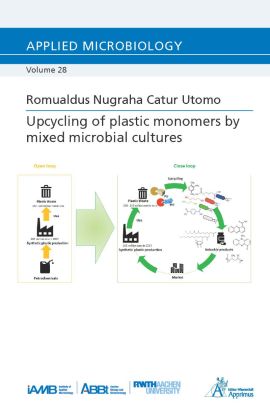Due to their robustness, versatile properties, and low price, plastics are used for such different applications as bone screws in medical applications and packaging in the food sector at ever-increasing amounts. The environmental problem caused by mismanaged plastic waste is prominent in many parts of this world, causing contaminations of the soil and marine ecosystems. To tackle this challenge, the end-of-life use of plastic must be considered in the value chain, including the fate of the polymers. A not yet industrially implemented possibility is to use waste plastic as a carbon source for microbes and produce value-added products. Ideally, the generated products have a higher value than the original plastic product and hence would not be just recycled but upcycled, a theme of the presented thesis.
Polyurethanes (PU) and polyethylene terephthalate (PET) are in the top 10 plastics produced and can either partially or fully be degraded using enzymes. These enzymes found in nature can hydrolyze these polymers, thereby releasing monomers like adipic acid, 1,4-butanediol, ethylene glycol, 2,4-toluenediamine, and terephthalic acid. The plastic monomers can be utilized as a carbon source by microorganisms like the biotechnological workhorse Pseudomonas putida KT2440 or new species like Pseudomonas capeferrum TDA1 to produce high-value products, like rhamnolipids, phenazine, and polyhydroxyalkanoates, presented in this thesis.
More specifically, this thesis presents a defined mixed culture utilizing the mock of a PU hydrolysate as a sole carbon source for growth and mono-rhamnolipid synthesis. The isocyanate derivative, 2,4-toluenediamine (TDA), exhibited strong inhibitory effects and hence was extracted prior to carbon use with 5 wt% di-(2-ethylhexyl) phosphoric acid (D2EHPA) in paraffin oil. The extraction of TDA was necessary, despite a member of the consortium could degrade this plastic monomer, indicating that the biochemical potential and the rates of the different members have to be taken into consideration in the design of mixed cultures.
P. capeferrum TDA1 can natively utilize adipic acid, 1,4-butanediol, and 2,4-toluenediamine, but not ethylene glycol and terephthalic acid. As an alternative approach, a consolidated mutant based on P. capeferrum TDA1 was established to utilize all monomers from PU and PET and to produce mono-rhamnolipids. Adaptive laboratory evolution was conducted to enable growth on ethylene glycol, while the tph operon from P. umsongensis GO16 was transformed to enable growth on terephthalic acid. The results are discussed in the context of the bow-tie structure of metabolism and plastic waste as a carbon source in a circular (bio)economy.
| Autor | Utomo, Romualdus Nugraha Catur |
|---|---|
| Gewicht | 0.21 kg |
| Erscheinungsdatum | 30.06.2022 |
Dissertationen
Upcycling of plastic monomers by mixed microbial cultures
Kurzbeschreibung
Our earth suffers a lot due to the increase of plastic waste. Due to the mismanagement, plastic waste enters the ocean and endangers the marine ecosystem. The upcycling, converting the plastic hydrolysate into valuable products, would transform the open loop of the plastic waste crisis into a circular bioeconomy for sustainability. As a result of enzymatic hydrolysis, the plastic monomers can be utilized by microbes as the sole carbon sources to produce various valuable products, such as rhamnolipids, phenazine, and PHA.

